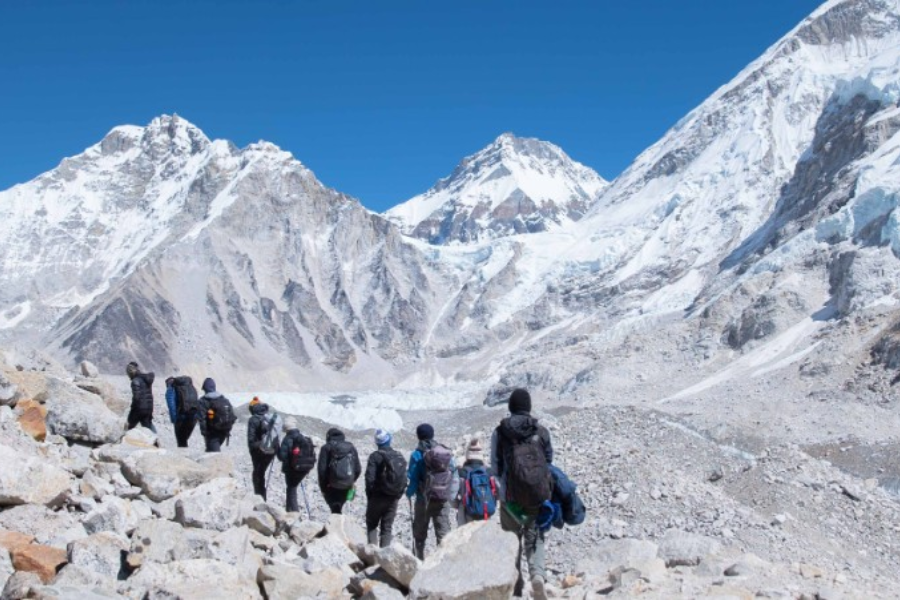Conquering Everest Base Camp A Journey Through the World’s Most Iconic Trek
Nestled in the heart of the Himalayas, the trek to Everest Base Camp (EBC) stands as a pilgrimage for adventurers, trekkers, and dreamers alike. The journey, extending over approximately 130 kilometers round-trip, traverses through some of the most breathtaking landscapes on Earth, offering a profound blend of physical challenge and awe-inspiring beauty. This iconic trek not only leads to the base camp of the world’s highest peak but also immerses travelers in the rich cultural tapestry of the Khumbu region, making it a journey of both physical endurance and spiritual enrichment.
The adventure typically begins in Lukla, a small mountain town accessible via a thrilling flight from Kathmandu. As trekkers disembark, they are immediately greeted by the grandeur of the Himalayas and the buzzing atmosphere of Lukla’s bustling market. From here, the path ascends gradually through the verdant Dudh Koshi River valley. The initial days are spent acclimatizing to the altitude, with stops in picturesque Sherpa villages such as Phakding and Namche Bazaar. Namche, often referred to as the gateway to the Himalayas, is a vibrant hub where trekkers can acclimatize while soaking in stunning panoramic views of Everest and neighboring peaks. The town’s bustling market, local monasteries, and vibrant atmosphere offer a glimpse into the daily lives and traditions of the Sherpa people.
As trekkers continue their ascent, the landscape transforms dramatically. Base camp trek The lush greenery gives way to a stark, rugged terrain dominated by towering peaks and glacial rivers. The trail meanders through high-altitude pastures, rocky paths, and picturesque suspension bridges. Each step brings a closer view of the majestic Himalayas, with the towering forms of Lhotse, Nuptse, and of course, Everest itself, coming into clearer focus. The trek is punctuated by iconic landmarks such as the Tengboche Monastery, a serene spiritual retreat perched above the treeline, offering not only spiritual solace but also spectacular vistas.
Reaching Dingboche and Lobuche marks the beginning of the final, exhilarating push toward Everest Base Camp. These higher altitudes demand extra acclimatization and a slow, steady pace. The journey from Lobuche to Gorak Shep, the last settlement before base camp, involves traversing a rocky, wind-swept landscape. The trail culminates at Everest Base Camp itself, a rugged expanse dotted with colorful expedition tents. The sight of Everest towering above, the surrounding icefall, and the sheer magnitude of the landscape offer a powerful sense of accomplishment and wonder.
Standing at Everest Base Camp, the culmination of a grueling yet exhilarating trek, one is enveloped by a profound sense of awe. The relentless power of nature and the indomitable spirit of those who venture here create an experience that is as transformative as it is unforgettable. Conquering Everest Base Camp is more than a physical achievement; it is a journey through raw, untouched beauty and a testament to human perseverance and adventure.
Introduction to Everest Base Camp Trek
The Everest Base Camp trek is one of the most renowned and sought-after adventures in the world. Situated in the Khumbu region of Nepal, this trek offers an unparalleled opportunity to experience the awe-inspiring beauty of the Himalayas and get up close to Mount Everest, the highest peak on Earth. Spanning approximately 130 kilometers round-trip, the journey typically takes around 12 to 14 days to complete, depending on the chosen itinerary and acclimatization needs. Trekkers traverse a variety of landscapes, from lush forests and vibrant Sherpa villages to barren, high-altitude terrain. The trek provides not only breathtaking views of towering peaks like Everest, Lhotse, and Nuptse but also a chance to immerse in the rich cultural heritage of the Sherpa people. The experience is as much about connecting with the natural beauty and spiritual essence of the Himalayas as it is about the physical challenge of reaching the base camp.
History of the Everest Base Camp Trek
The history of the Everest trek logistics is deeply intertwined with the broader history of mountaineering. The trek gained prominence in the early 20th century, particularly after the famous expeditions led by Sir Edmund Hillary and Tenzing Norgay, who made the first successful ascent of Mount Everest in 1953. Before this historic climb, the trek served as a route for explorers and climbers preparing for their ascent. Over the decades, it evolved into a popular trekking destination, attracting adventurers from around the globe. The route was initially used by mountaineers to acclimatize and establish base camps for their climbs, but its natural beauty and cultural significance soon made it a destination in its own right. Today, the Everest Base Camp trek stands as a testament to the enduring allure of the Himalayas and the spirit of exploration.
Preparing for the Journey
Preparing for the Everest Base Camp trek involves both physical conditioning and logistical planning. Given the trek’s challenging terrain and high altitudes, it is crucial to build cardiovascular endurance, strength, and stamina through regular exercise such as hiking, running, or cycling. Additionally, acclimatization is a key factor; hence, understanding the symptoms of altitude sickness and how to prevent it is essential. Logistically, trekkers should arrange their permits and trek package well in advance, as the trek requires several permits including the TIMS card and Sagarmatha National Park entry permit. It is also important to consult with a travel agency or guide who can provide valuable insights and support throughout the journey. Proper training, planning, and guidance ensure a safer and more enjoyable trekking experience.
Best Time to Trek
The best time to undertake the Everest Base Camp trek is during the pre-monsoon (spring) and post-monsoon (autumn) seasons. Spring, from late March to early June, offers stable weather conditions and clearer skies, providing stunning views of the surrounding peaks and optimal trekking conditions. This period is also when many climbers prepare for their Everest expeditions, adding a vibrant atmosphere to the trail. Autumn, from late September to early November, is another excellent time to trek, with cooler temperatures and clear skies making for comfortable trekking conditions and spectacular mountain views. Both seasons offer relatively stable weather compared to the summer monsoon and harsh winter months, when heavy snowfall and poor visibility can pose significant challenges.
Essential Gear and Equipment
Embarking on the Everest Base Camp trek necessitates a careful selection of gear and equipment to ensure comfort and safety. Essential items include a high-quality trekking backpack, durable hiking boots with good ankle support, and layered clothing to adapt to varying temperatures. A waterproof and windproof jacket, thermal base layers, and a warm down jacket are crucial for insulation. Trekking poles provide stability on uneven terrain, while a sleeping bag rated for cold temperatures ensures warmth during nights at higher altitudes. Additionally, a good quality water bottle or hydration system, high SPF sunscreen, and sunglasses to protect against the intense mountain sun are essential. A first-aid kit, personal medications, and a reliable headlamp with extra batteries are also recommended. Proper gear ensures a more comfortable and safe trekking experience.
Overview of the Trek Route
The Trekking accommodation follows a meticulously crafted route that offers trekkers a journey through some of the most dramatic landscapes on Earth. The trek typically begins in Lukla, where trekkers fly in from Kathmandu and commence their trek through the Khumbu region. The initial section takes you through Phakding, following the Dudh Koshi River before reaching the vibrant village of Namche Bazaar. This bustling town serves as an essential acclimatization stop due to its altitude and provides an opportunity to explore local markets and cultural sites. From Namche, the route ascends through Tengboche, renowned for its stunning monastery and panoramic mountain views, before continuing to Dingboche and Lobuche. The final leg of the trek from Lobuche to Gorak Shep, and then to Everest Base Camp, presents a more challenging terrain of rocky paths and icy glaciers. The return journey retraces the route, often taking a slightly different path to explore additional areas before concluding back in Lukla.
Altitude and Acclimatization
Altitude plays a crucial role in the Everest Base Camp trek, with the journey reaching an elevation of 5,364 meters (17,598 feet) at the base camp. Proper acclimatization is essential to prevent altitude sickness, which can affect trekkers due to the lower oxygen levels at high altitudes. The trek is designed with strategic acclimatization stops, such as Namche Bazaar and Dingboche, where trekkers spend extra days to adapt. The general guideline is to ascend slowly and allow the body to adjust, which helps in mitigating the risks associated with high-altitude trekking. Symptoms of altitude sickness can include headaches, nausea, and dizziness, so it is crucial to stay hydrated, maintain a slow pace, and listen to one’s body. In severe cases, descending to a lower altitude is necessary for recovery. Adequate preparation and awareness of these altitude-related issues significantly enhance the trek experience and ensure safety.
Key Highlights Along the Trail
The Everest Base Camp trek cost is rich with key highlights that captivate trekkers throughout the journey. One of the initial highlights is the vibrant Namche Bazaar, with its lively market and panoramic views of Everest, Lhotse, and Ama Dablam. Tengboche Monastery, perched high above the tree line, offers both spiritual solace and spectacular views of the surrounding peaks. The trek also features stunning landmarks such as the Khumbu Icefall, an awe-inspiring glacier that cascades down the mountainside, and the serene lake of Gokyo, often visited as a side trek for its breathtaking beauty. The final destination, Everest Base Camp, provides a close-up view of the majestic Everest and an unparalleled sense of achievement. Throughout the trek, the diverse landscape, from lush rhododendron forests to stark high-altitude deserts, continually offers new and striking vistas.
Cultural Insights: Sherpa Traditions
The Everest Base Camp trek is not only a physical journey but also a cultural immersion into the traditions and lifestyle of the Sherpa people. Sherpas, an ethnic group native to the region, are renowned for their mountaineering skills and deep spiritual connection to the Himalayas. Along the trek, trekkers encounter traditional Sherpa villages where they can witness local customs and hospitality. Key cultural experiences include visiting monasteries, such as the Tengboche Monastery, where prayers and rituals are performed daily. Sherpa festivals, like the Mani Rimdu, provide insight into local religious practices and community celebrations. The Sherpas’ deep respect for the mountains, considered sacred in Tibetan Buddhism, is reflected in their daily lives and the numerous prayer flags and stupas found along the trail. Engaging with Sherpa guides and porters, who share their knowledge and stories, offers a deeper understanding of the region’s cultural heritage and the values that sustain their way of life.
Health and Safety Considerations
Health and safety are paramount on the Everest Base Camp trek, given the demanding conditions and high-altitude environment. To ensure safety, trekkers should be well-prepared with a comprehensive health plan. Carrying a first-aid kit with basic medical supplies and any personal medications is essential. Proper acclimatization, as previously mentioned, is crucial to prevent altitude sickness. Staying hydrated, eating a balanced diet, and getting adequate rest are key to maintaining health throughout the trek. Trekkers should also be aware of the risks associated with weather changes, such as cold temperatures and high winds, which necessitate appropriate clothing and gear. It is advisable to trek with a guide or tour company that provides support and can handle emergencies. Additionally, understanding and respecting local customs and regulations, such as obtaining necessary permits and following trail guidelines, contributes to a safe and respectful trekking experience.
Environmental Impact and Sustainability
The Himalayan trekking maps, while a magnificent adventure, comes with significant environmental impacts that necessitate a focus on sustainability. The influx of trekkers and climbers puts a strain on the region’s fragile ecosystems, contributing to issues such as littering, deforestation, and pollution. To mitigate these impacts, it is crucial for trekkers to follow Leave No Trace principles, including packing out all waste and minimizing environmental disturbance. Local initiatives, such as the Sagarmatha Pollution Control Committee (SPCC), work towards keeping the trail clean and promoting responsible trekking practices. The introduction of eco-friendly practices, like the use of biodegradable waste bags and the promotion of sustainable trekking gear, helps reduce the trek’s carbon footprint. Supporting local businesses and using certified guides who adhere to environmental standards also plays a vital role in fostering sustainability. By being mindful of these practices, trekkers contribute to preserving the beauty of the Himalayas and supporting the long-term health of this iconic trekking destination.
Tips for a Successful Trek
Success on the Everest Base Camp trek hinges on thorough preparation and thoughtful planning. First and foremost, physical fitness is crucial; regular hiking, cardiovascular exercises, and strength training can significantly enhance endurance and overall trekking experience. Proper acclimatization is essential, so allow extra days for adjustment to higher altitudes and listen to your body for any signs of altitude sickness. Packing wisely is another key to success; bring layered clothing to adapt to varying temperatures, sturdy hiking boots, and essential gear like trekking poles and a quality sleeping bag. It is also beneficial to stay hydrated, eat nutritious food, and maintain a steady pace throughout the trek. Engaging with experienced guides and porters not only enhances safety but also enriches the experience through their knowledge and support. Finally, maintaining a positive attitude and flexibility in your plans can greatly contribute to a successful and enjoyable trekking experience.
Personal Experiences and Stories
Personal experiences from the Everest Base Camp trek are as diverse as the trekkers themselves, each story adding a unique dimension to the adventure. Some describe the exhilaration of standing at the base of the world’s highest peak, feeling an overwhelming sense of achievement and connection to the natural world. Others recount the camaraderie formed with fellow trekkers and the invaluable guidance received from Sherpa guides, whose stories and warmth enhance the journey. Anecdotes often highlight moments of awe, such as witnessing breathtaking sunrises over the Himalayas or navigating challenging weather conditions. Many trekkers share personal transformations, including newfound resilience, a deeper appreciation for nature, and a profound respect for the cultural heritage of the region. These stories underscore the trek’s capacity to leave lasting impressions and create lifelong memories.
Conclusion: The Reward of Reaching Base Camp
Reaching Everest Base Camp is a culmination of physical endurance, mental fortitude, and profound personal achievement. Standing at the base camp, with the towering presence of Mount Everest and the surrounding Himalayan giants, offers a sense of awe and accomplishment that few experiences can match. The journey to this point is often marked by trials and triumphs, from navigating rugged terrain to adapting to high altitudes. However, the reward lies not only in the final destination but also in the journey itself—the stunning landscapes, the cultural interactions, and the personal growth achieved along the way. The sense of achievement and the breathtaking views serve as a powerful reminder of the beauty and challenge of nature. Reaching Everest Base Camp symbolizes more than just reaching a physical destination; it represents a personal victory and a deep connection to one of the world’s most extraordinary environments.
Resources for Further Exploration
For those inspired to explore the Everest Base Camp trek further, several resources provide valuable information and support. Guidebooks such as “Everest Base Camp Trek: A Comprehensive Guide” by Kevin Raub offer detailed insights into the trek, including maps, itineraries, and practical tips. Websites like the Himalayan Rescue Association provide essential health and safety advice for high-altitude trekking. Travel forums and blogs, such as Trekking Nepal or Lonely Planet’s trekking section, offer personal experiences, tips, and recommendations from fellow trekkers. For those seeking organized treks, reputable companies like G Adventures or Intrepid Travel offer guided tours with comprehensive support. Additionally, local organizations like the Nepal Tourism Board can provide updated information on permits, regulations, and sustainability efforts. Utilizing these resources can enhance your planning and ensure a rewarding and well-prepared trekking experience.
Discover the latest news and updates on Gaze Up






